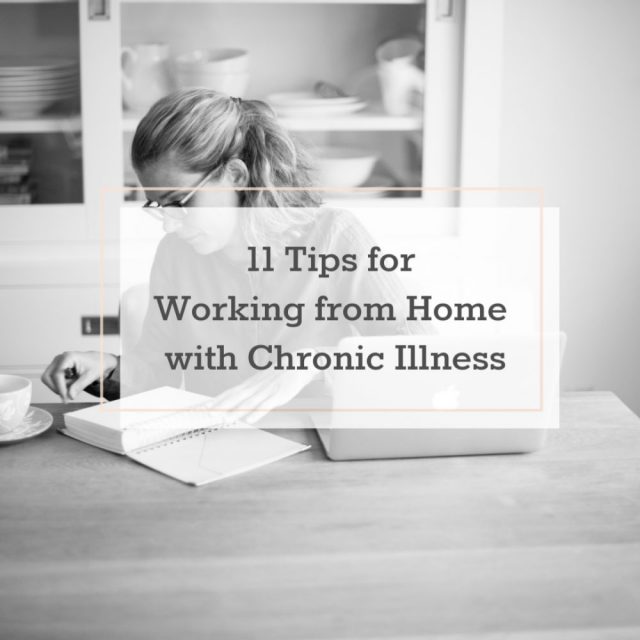How to Lead a Balanced Lifestyle with Chronic Illness

Combining a career and chronic illness is a real challenge. Just getting into the office each day may be more than your body can handle. When you’re healthy enough to earn a living, working from home may be a good solution. Depending on your specific job, you usually have more control over your work schedule and work load. Plus, there’s no commute, no noisy workplace and looking presentable is optional.
Luckily, there are all kinds of jobs you can do from the comfort of your own home. From freelance writing and online coaching to being a virtual assistant or selling stock photography, you can find tons of ideas online. With a good dose of creativity, determination and discipline, other spoonies are earning a living selling apparel on Etsy, creating subscription boxes and even online yoga teaching from bed!
But working from home comes with its own potential problems, like procrastinating, lack of human interaction, blurred lines between work-home life and having to deal with everything by yourself. Not to mention having to deal with the limitations of an unpredictable chronic illness.
So how can you successfully run a business or freelance career when you suffer from health problems? How do you stay productive on flare-up days? Take a look at these 11 tried-and-tested tips for working from home with chronic illness.

As tempting as it is to run your business from bed, balancing your laptop on your lap isn’t great for your posture (nor for good sleep hygiene by the way). So if you can, settle yourself behind a proper desk on an adjustable chair. Make sure your workstation has the right height for you, especially if you have muscle or joint problems.
What’s more, remote work usually involves a lot of staring at screens. To keep your eyes healthy, keep your computer screen at arm length away from your face and take a break every 2 hours. You can also use a matte filter on your electronic devices to prevent eye strain.
Also, don’t overlook the impact that natural light, fresh air and the presence of plants has on your energy levels, attention span, mood and overall health. Open your windows, let the sunshine in and ventilate your home office daily.
This may seem like a no-brainer, but when there are no boundaries between work and home life you probably either waste too much time watching YouTube or find yourself glued to your laptop at all hours of the day.
That’s why it helps to set a work schedule. If you don’t have a boss or client contact, you can be more flexible and follow a predictable rhythm instead of a strict timetable. Just be consistent. That makes it easier to get into a focused work flow and to manage your energy.
When there are little ‘zeitgebers’ in your day that provide structure, you can set a number of alarms to remind you it’s time to get started, take breaks and wrap up your work day. To get a good night’s sleep, make sure you stop working and wind down at least one hour before bedtime. In the long-run, high-quality rest is the best productivity tool there is.
Having an overview of which tasks you need to tackle is key. But not being able to check off an ambitious never-ending to-do list can make you feel hopeless and exhausted.
There are different ways to write a to-do list you can actually, well, do. What works really well for me is to have monthly and weekly goals instead of (only) daily goals. That way, when I’m having a day with little focus, energy or some other obstacle that pops up, I can move part of my tasks to the next work day, without stress. I also build in ‘buffer’ time, a little extra time before a deadline, so there’s less pressure to push through when I’m not feeling well.
It also helps to break down big (monthly) goals into small, actionable chunks. More so, be specific when writing your to-do list. Don’t jot down “social media” in your planner, but rather something like “schedule 10 posts for Facebook, Instagram and Pinterest for the coming week”.
During which times of day do you feel most energetic and focused? Take advantage of your most productive times of day by scheduling work that demands your full attention. Michael Breus, author of The Power of When, says you should reserve your peak hours for analytic and strategic tasks. Then, when your alertness drops, your creativity rises – making that the perfect time of day for brainstorming, creating and gaining new insights.
You can use this knowledge to boost your productivity, even on bad days. Break down your to-do list in high-focus and low-focus tasks, and tackle them during the right time of day.

When you’re living with chronic illness and limited energy, you need to pace yourself to get things done without hurting your health. Pacing means finding the right balance between activities and rest. One way to do that is by alternating work with breaks.
When you’re (finally) in a work flow, it’s tempting to just go on for hours, only getting up for a quick bathroom visit. But it turns out that I’m much more productive when I actually set alarms on my phone to take a coffee, lunch and afternoon break. Instead of pushing on until I’m tired, I get up and away from my computer before my energy runs out. And that results in getting much more done at the end of the day than when I crash around 3pm.
So make sure you schedule real breaks, during which you get up, stretch your legs, refuel and recharge. Scoffing down your lunch behind your desk doesn’t count!
Oh and if you’re having a bad day and need an additional break: take it.
You may not have colleagues showing up at your desk or a noisy office, but working from home comes with its own distractions. Maybe you have kids in other parts of the house, a friendly neighbor who keeps dropping in or the postman dropping off packages for the entire neighborhood (yep, that happens to me). Not to mention how distracting your own body and mind can be with annoying symptoms and intrusive thoughts popping up.
Studies have shown that, as much as we all believe we are good at multitasking, our brains aren’t good at handling different input at once. So conserve your mental energy for your work by limiting distractions:
You can’t completely prevent distractions from happening, but you can find ways to better manage them.
Now I know that not having a commute is one of the upsides of working from home. But I’ve found that moving my body before sitting down to work hugely improves my functioning. On days when I cycle my kids to school and daycare, I feel much more energetic, mentally sharp and bubbling with ideas than on days when I head straight to my desk. Makes sense of course, because the gentle exercise and fresh air stimulate my circulation, sending blood rich in oxygen and nutrients throughout my body.
You don’t have to hop on your bike or go for a walk first thing in the morning to get your blood flowing. However, you should get up regularly from your desk to stretch your legs. Boost your circulation and your productivity by going for a stroll during your lunch break, circling your joints or doing these easy stretches at your desk.
There’s no escaping it: some days your symptoms will flare up and you’ll feel like curling up under the covers while there’s a pile of work waiting for you. How do you deal with bad days when you’re working at home with chronic illness?
Unfortunately, there’s no one-size-fits-all answer to this question. So much depends on your personal situation: your health, the type of work you do, if you have clients and a boss waiting for your input. What does help, is making your own plan for scenarios like this. Before I had my own ‘rules’ to fall back on, I used to handle sick days badly. I would try to get things done, but worked slow and inefficiently. In the end, I wasn’t productive at all, but didn’t take time to rest up and get better either. Nowadays, I often just tackle the most important task(s) of that day and then really focus on recovering as quickly as possible.
Lesson: Know when resting is more productive than keeping going.

If you’re a freelancer or self-employed, your job involves more than just getting the work done. You have to get new clients, market and sell your products or services, sort out your administration and wear all kinds of different hats.
When you have limited energy, it’s easy to get absorbed by the day-to-day ‘urgent’ things to do. But don’t overlook the bigger picture. Independent business blog Fizzle notes there are two types of work modes: CEO and Worker Bee. Both the planning mode and the doing mode are essential to bring an idea to execution.
So make sure you also schedule in time for tasks that are not urgent, but still important – what Stephen Covey called Quadrant II. If you’re strapped for time and resources, you might put things like long-term planning, investments or personal development to the back burner. But eventually, this might catch up with you.
Working from home can be lonely and isolating, especially if your mobility is limited as a result of chronic illness. It’s also hard going at it alone all the time, feeling like you have to re-invent the wheel. So for your personal sanity and professional network, stay in touch with people.
And don’t just virtually connect. If you’re healthy enough, meet up friends and fellow solopreneurs for coffee or have dinner with family after a long day of being cooped up at home. We are all wired to connect.
Inevitably, there will be days when you’re too sick to work. Wouldn’t it be ideal if you didn’t have to stress (too much) over meeting deadlines? Although things won’t always work out smoothly, having a back-up plan in place makes it easier to deal with the unexpected situation. For example, I like to plan ahead and schedule blog posts plus social media ahead of time. For you, having a coworker or virtual assistant who can take over some tasks on sick days might be most effective.
In that spirit, it’s also wise to have a back-up plan for other work-related things that could go wrong, like internet outage, technological hiccups or not getting paid within the agreed period.
Just like all aspects of living with chronic illness, working from home comes with its challenges. But I’m very grateful we live in a time that makes it possible to earn a living and share your talents from your own place at your own pace.
What’s your best tip for working from home with chronic illness?
If you enjoyed reading this article, you might also like: